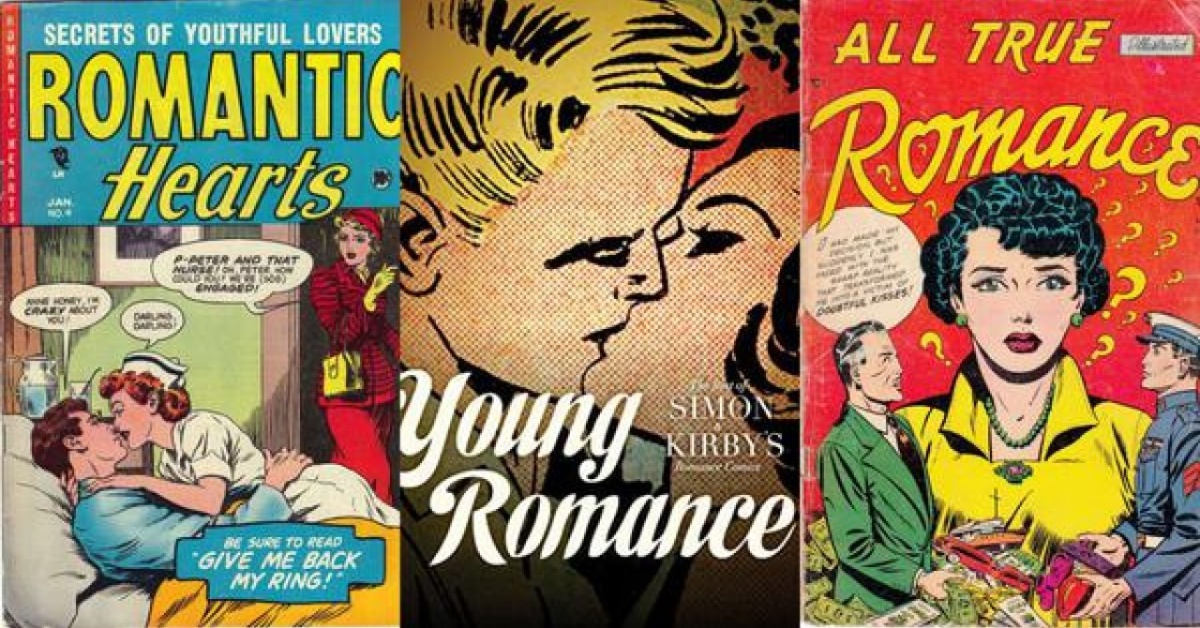
The Beginning
After World War II, Americans were tired of the conflict-heavy storylines of superhero comics. Previous wartime mainstays like Captain America just weren't selling well. So publishers turned to a new (for comics) genre: Romance.
In 1947 Jack Kirby (Doctor Doom, the Hulk, Thor, Iron Man, Magneto, Uatu the Watcher, the original X-Men, the Inhumans, the Black Panther, Ego the Living Planet, Galactus, and the Silver Surfer) and Joe Simon (Bucky Barnes, Captain America, Red Skull, Betsy Ross, Vision, original Sandman) made a comedic romance comic called My Date in the style of Archie comics. It was a success, and they went on to make the wildly popular series Young Romance: Designed For The More Adult Readers Of Comics. While it was not the first romance comic — Calling All Girls ;included romance comics and came out in 1941, for example — Young Romance sold almost a million copies. Simon and Kirby (who received 50% of the profits) made a lot of money along with kick starting the romance genre for comics.
Competitors like Marvel and DC quickly arrived on the romance comic scene. The shelves were filled with Marvel titles like My Romance, Love Romances, Love Adventures, Love Tales, Love Drama, My Love, Our Love, and more. DC also joined in with Girls’ Love Stories, Secret Hearts, Girls’ Romances, Falling in Love, Heart Throbs, and purchased Young Romance from Prize Comics. All in all, there were almost 150 different romance titles from over 20 publishers in the time between 1947 and 1970, with most of the titles having been published by the mid 50’s.
Before romance comics, women were rarely seen creating comics or holding important positions in the companies. The rush to make romance comics was when more women were hired, and started to be included in creative or leadership roles in comics. Some of these include Zena Brody, Ruth Brandt, Phyllis Reed, and Dorothy Woolfolk. Unfortunately, the representation of women remained low and remains around 20% to this day.
Comics Code Authority Appears
In 1954, the infamous Comics Code was implemented. This code dictated what could be published and included guidelines such as: people in positions of authority could not be disrespected or portrayed in a negative light, crimes cannot be portrayed in any way that creates sympathy for the criminal, and banned the words 'horror' and 'terror' from comics titles. It also banned a whole slew of things found in comics like gore, nudity, adultery, and anything they considered “sexual perversion”. Romance comics were obviously affected, the code helped kill off a lot of comic genres at this time. For romance comics, reprints of old issues included changes to titles, dialogue, and plot. The new romance comics were much tamer now that “salacious,” “seductive,” and “indecent” content was verboten. A saturated market helped the decline of romance comics in the 1950s, but the Comics Code made it impossible for comics to compete with non-censored mediums. Romance novels rose in popularity, along with soap operas on television, and romance comics declined. Most titles were discontinued by the 1960’s.
By 1970 only a few romance comics remained, such as Young Romance. With the Comics Code Authority weakening, these titles were more free to explore things previously forbidden: social upheaval, interracial relationships, and women’s rights. Other comics borrowed the style and tropes from romances to create love triangles (Wolverine, Jean Grey, and Cyclops in X-Men), teenage struggles with love (Spider Man), or soap opera storylines (Avengers).
Today
Modern romance comics include: Strangers in Paradise, Bingo Love, Alex + Ada, Blankets, and many more. There's even a graphic novel guide to help explain consent! Modern romance protagonists are free to keep their jobs, value their career, ignore traditional gender roles, show no interest in marriage, and be LGBTQ+. There are not many comics that are solely romance, but readers can find plenty of great (and terrible) love stories in all sorts of issues. What are some of your favorite ones?
Some comic book couples that have transcended the medium include: Harley Quinn and Poison Ivy (Joker is a toxic nightmare, fight me), Clark Kent and Lois Lane, Peter Parker and Mary Jane, Jean Grey and Scott Summers, Vision and Scarlet Witch, and one day soon perhaps Hulkling and Wiccan on Disney Plus. Below you will find a list of comics and related materials available at San Jose Public Library.
Sources
- Tales From the Code: You’ve Lost That Loving Feeling by Joe Sergi
- Not All Heroes Wear Capes: America’s postwar fling with romance comics – and the massive collection of those comics that was recently donated to the university of South Carolina by Michael C. Weisenburg.
- A Brief History of Romance Comics



Add a comment to: History of Romance Comics in the USA